It was last year this time when I was dining with a friend who I had agreed to endure for the next 60 minutes of small talk. For better or for worse, the server walks in and hands over a huge list of unrecognisable names. My dining companion looks hesitant, discards the menu and quickly asks for an on-the-rocks and vodka-tonic for the lady. He senses my curiosity and grins, “Why would you order wine if you don’t know anything about it?” I’m offended, he’s ignorant and that was awkward. You would have guessed by now, the dinner ended sooner than I thought.I admit; I’m fairly new to the world of wine but I have enough knowledge to order myself a glass of wine and in all probability a memorable one. I know it’s intimidating and often embarrassing to order wine with a name that you can barely pronounce but there’s no reason to let the fuss around it stop you from making it a delicious addition to your meal.I sat down with three wine experts to uncork the best tips you can take with you to the restaurant. These are easy rules for ordering wine like a pro. At the very least, you’ll enjoy your drink, if not your company.
When the waiter shows you the bottle, check the label to see the name of the producer and the grape. This way you’ll begin to differentiate between wines and learn what you like and the characteristics they have. Whites like Chardonnay, Sauvignon Blanc and Riesling and reds like Cabernet Sauvignon, Syrah and Pinot Noir usually appear on menus. If you are still not sure, order a sparkling wine like Champagne and Prosecco or a Rosé. The bubbles in sparkling wines make them more amenable with most dishes. A rosé has the acidity and freshness of a white while the light tannins give it a little more weight so that it crosses over between a red and a white - Reva Singh, Publisher & Editor of Sommelier India - The Wine Magazine
2. Vintage versus House WineMost restaurants serve you house wine which could be a cheap wine or entry level wine-with or without a label. Basically, it is sold by the glass and affordable but generally drinkable enough to order a glass or two. A good restaurant has decent quality wines which are changed frequently.Vintage merely indicates the year in which the grapes were harvested. It’s significant because for ordinary white wines the life may be 2-3 years and in red wines it’ll be 3-5 years after which it starts going down in terms of drinkability. In regions like Bordeaux, Burgundy and Barolo where the climate varies significantly, the quality difference is discernible. For fine wines, it is important to see how it evolves year after year - Subhash Arora, Founder President of Indian Wine Academy and Delhi Wine Club
The primary difference between sweet and dry wines is in their sugar content. A dry wine may contain less than 1% residual sugars, or less than 5% for a ‘bone dry’ wine (below which a human palette can detect no sugars). On the other hand, a sweet (or dessert) wine may contain 20% or more residual sugar. Most common table wines that people would normally drink with dinner have little to zero residual sugar in them. This includes Cabernet Sauvignon, Merlot, Pinot Noir, Syrah and Chardonnay. Dry wines are more acidic and just about anything you’re going to order from the non-dessert wine list is going to be dry. Especially, the reds. The exception to this rule, would be a Riesling – Rinku Madan, Food Writer and Wine ExpertChoose fruity, slightly sweet (called off-dry) wines. Avoid an oaked white wine and red wine with high tannins like Cabernet Sauvignon if you are a novice. Usually, you would not go wrong with a Merlot, Malbec, Shiraz and a Chardonnay, Sauvignon Blanc or Pinot Grigio - Subhash Arora, Founder President of Indian Wine Academy and Delhi Wine Club
4. To decant or not to decant?
This is a personal choice but usually done for older red wine. Over 95% wines don’t need it. Complex wines (expensive reds) should be decanted for 30-60 minutes. Generally, mature wines (say over 30 years) should be decanted to remove the sediments but for a short time of 15-30 minutes White wines do not normally need decanting unless they were matured in oak casks. It is best to pour wine in a bigger glass and let it stay in the glass. It will open up better with oxygen coming in contact with the surface - Subhash Arora, Founder President of Indian Wine Academy and Delhi Wine Club5. The perfect pairWhile white wine with white food and red wine with red food is the general rule, I feel it is better to match the textures- light wine with light textured food. Body indicates the texture of wine-usually categorised as light, medium or full bodied. It depends on the grapes and alcohol level. So, a grilled or poached fish dish would go well with a light Sauvignon and fish with tartare sauce pairs better with a full bodied white like Chardonnay. Salmon fish can also match red wine like Pinot Noir. Most vegetarian dishes pair well with light-to medium bodied white wines. Dishes with mushrooms, truffle, asparagus, and spinach can also go with red wines. Avoid highly tannic wines, especially with spicy food as tannins add to the chilli heat. If you love chillies, you may also like Shiraz - Subhash Arora, Founder President of Indian Wine Academy and Delhi Wine ClubContrasting flavor means you are trying to offset a taste or structural element in the wine and food. Sometimes this works, sometimes it doesn’t. Do match creamy with crisp and spicy and sweet. Pair Riesling, Pinot Gris (Alsace style) or Gewurztraminer with spicy Thai or Indian food. It’s a great combo. Do not match tannin with sweet or acid – Rinku Madan, Food Writer and Wine Expert6. Nose the wineTo know if the wine is corked (gone bad), swirl and then sniff. Corked is a condition where the wine might be contaminated with certain micro-organisms that have infected the cork. Corked wine will generally have a musty smell, like a wet cardboard or newspaper. The taste will be flat and dull with no fruity notes. Some say corked wine tastes astringent. Don’t feel shy in returning the bottle if you find anything unusual. Try and try again to be absolutely sure you like the wine - Reva Singh, Publisher & Editor of Sommelier India - The Wine Magazine7. The right temperature mattersNothing spoils a wine more than serving it at the wrong temperature. The temperature can dramatically impact the way a wine smells and tastes. A general rule - white wines should be served chilled and red wines at room temperature. Keeping in mind the Indian weather, it’s always better to serve your reds a little cooler at 15°-18° as you can always warm up the glass in the palm of your hand. For whites, 2-3 hours in the fridge is perfect, but no more, as white wines should never be served under 5° because it will turn acidic. Sparkling wine should be served ice cold. The ice cold temperature will keep the bubbles fine rather than foamy. Let the server pour it for you as he knows best - Rinku Madan, Food Writer and Wine ExpertAbove all, you want to be curious because that’s the most important characteristic of a confident wine lover.
1. Learn the vocabulary of the grape
When the waiter shows you the bottle, check the label to see the name of the producer and the grape. This way you’ll begin to differentiate between wines and learn what you like and the characteristics they have. Whites like Chardonnay, Sauvignon Blanc and Riesling and reds like Cabernet Sauvignon, Syrah and Pinot Noir usually appear on menus. If you are still not sure, order a sparkling wine like Champagne and Prosecco or a Rosé. The bubbles in sparkling wines make them more amenable with most dishes. A rosé has the acidity and freshness of a white while the light tannins give it a little more weight so that it crosses over between a red and a white - Reva Singh, Publisher & Editor of Sommelier India - The Wine Magazine
2. Vintage versus House WineMost restaurants serve you house wine which could be a cheap wine or entry level wine-with or without a label. Basically, it is sold by the glass and affordable but generally drinkable enough to order a glass or two. A good restaurant has decent quality wines which are changed frequently.Vintage merely indicates the year in which the grapes were harvested. It’s significant because for ordinary white wines the life may be 2-3 years and in red wines it’ll be 3-5 years after which it starts going down in terms of drinkability. In regions like Bordeaux, Burgundy and Barolo where the climate varies significantly, the quality difference is discernible. For fine wines, it is important to see how it evolves year after year - Subhash Arora, Founder President of Indian Wine Academy and Delhi Wine Club
3. Know the style
The primary difference between sweet and dry wines is in their sugar content. A dry wine may contain less than 1% residual sugars, or less than 5% for a ‘bone dry’ wine (below which a human palette can detect no sugars). On the other hand, a sweet (or dessert) wine may contain 20% or more residual sugar. Most common table wines that people would normally drink with dinner have little to zero residual sugar in them. This includes Cabernet Sauvignon, Merlot, Pinot Noir, Syrah and Chardonnay. Dry wines are more acidic and just about anything you’re going to order from the non-dessert wine list is going to be dry. Especially, the reds. The exception to this rule, would be a Riesling – Rinku Madan, Food Writer and Wine ExpertChoose fruity, slightly sweet (called off-dry) wines. Avoid an oaked white wine and red wine with high tannins like Cabernet Sauvignon if you are a novice. Usually, you would not go wrong with a Merlot, Malbec, Shiraz and a Chardonnay, Sauvignon Blanc or Pinot Grigio - Subhash Arora, Founder President of Indian Wine Academy and Delhi Wine Club
4. To decant or not to decant?
This is a personal choice but usually done for older red wine. Over 95% wines don’t need it. Complex wines (expensive reds) should be decanted for 30-60 minutes. Generally, mature wines (say over 30 years) should be decanted to remove the sediments but for a short time of 15-30 minutes White wines do not normally need decanting unless they were matured in oak casks. It is best to pour wine in a bigger glass and let it stay in the glass. It will open up better with oxygen coming in contact with the surface - Subhash Arora, Founder President of Indian Wine Academy and Delhi Wine Club5. The perfect pairWhile white wine with white food and red wine with red food is the general rule, I feel it is better to match the textures- light wine with light textured food. Body indicates the texture of wine-usually categorised as light, medium or full bodied. It depends on the grapes and alcohol level. So, a grilled or poached fish dish would go well with a light Sauvignon and fish with tartare sauce pairs better with a full bodied white like Chardonnay. Salmon fish can also match red wine like Pinot Noir. Most vegetarian dishes pair well with light-to medium bodied white wines. Dishes with mushrooms, truffle, asparagus, and spinach can also go with red wines. Avoid highly tannic wines, especially with spicy food as tannins add to the chilli heat. If you love chillies, you may also like Shiraz - Subhash Arora, Founder President of Indian Wine Academy and Delhi Wine ClubContrasting flavor means you are trying to offset a taste or structural element in the wine and food. Sometimes this works, sometimes it doesn’t. Do match creamy with crisp and spicy and sweet. Pair Riesling, Pinot Gris (Alsace style) or Gewurztraminer with spicy Thai or Indian food. It’s a great combo. Do not match tannin with sweet or acid – Rinku Madan, Food Writer and Wine Expert6. Nose the wineTo know if the wine is corked (gone bad), swirl and then sniff. Corked is a condition where the wine might be contaminated with certain micro-organisms that have infected the cork. Corked wine will generally have a musty smell, like a wet cardboard or newspaper. The taste will be flat and dull with no fruity notes. Some say corked wine tastes astringent. Don’t feel shy in returning the bottle if you find anything unusual. Try and try again to be absolutely sure you like the wine - Reva Singh, Publisher & Editor of Sommelier India - The Wine Magazine7. The right temperature mattersNothing spoils a wine more than serving it at the wrong temperature. The temperature can dramatically impact the way a wine smells and tastes. A general rule - white wines should be served chilled and red wines at room temperature. Keeping in mind the Indian weather, it’s always better to serve your reds a little cooler at 15°-18° as you can always warm up the glass in the palm of your hand. For whites, 2-3 hours in the fridge is perfect, but no more, as white wines should never be served under 5° because it will turn acidic. Sparkling wine should be served ice cold. The ice cold temperature will keep the bubbles fine rather than foamy. Let the server pour it for you as he knows best - Rinku Madan, Food Writer and Wine ExpertAbove all, you want to be curious because that’s the most important characteristic of a confident wine lover.
Advertisement









